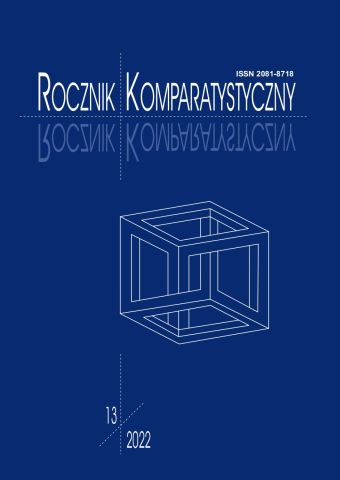





| Autorzy: |
Klara
Szmańko

Uniwersytet Opolski |
| Słowa kluczowe: | Maxine Hong Kingston China Men “The Laws ” Amerykanie chińskiego pochodzenia chińscy imigranci Amerykanie azjatyckiego pochodzenia białość biali ludzie biali Amerykanie studia nad białością oksymoron białości prawna konstrukcja białości |
| Data publikacji całości: | 2022 |
| Liczba stron: | 18 (213-230) |
Cytowanie: Szmańko, Klara. “The Legal Oxymoron of Whiteness in “The Laws” Chapter of China Men byMaxine Hong Kingston”. Rocznik Komparatystyczny 13 (2022): 213–230. DOI: 10.18276/rk.2022.13-11.
| 1. | Babb, Valerie. Whiteness Visible: The Meaning of Whiteness in American Literature and Culture. New York: New York University Press, 1998. |
| 2. | Bedhad, Ali. A Forgetful Nation. On Immigration and Cultural Identity in the United States. Durham–London: Duke University Press, 2005. |
| 3. | Bennett, Juda. The Passing Figure. Racial Confusion in Modern American Literature. New York: Lang, 1996. |
| 4. | Chan, Sucheng. Asian Americans: An Interpretive History. Boston: Twayne, 1990. |
| 5. | Foucault, Michel. “Body/Power.” Power/Knowledge. Selected Interviews and Other Writings. Ed. Colin Gordon. Brighton: Harvester, 1980. 5562. |
| 6. | ------. Power. Ed. James D. Faubion. New York: The New Press, 2000. |
| 7. | Frost, Linda. Never One Nation: Freaks, Savages and Whiteness in U.S. Popular Culture. Minneapolis: University of Minnesota Press, 2005. |
| 8. | Harris, Cheryl. “Whiteness as Property.” The Harvard Law Review 106.8 (1993): 1709–1791. |
| 9. | Hing, Bill Ong. Making and Remaking Asian America Through Immigration. Stanford: Stanford University Press, 1993. |
| 10. | Ichigashi, Yamato. “Emigration from Japan and Thence Their Immigration Into the State of California.” PhD Thesis. Cambridge, MA: Harvard University, 1913. |
| 11. | Kalogeras, Yiorgos. “Producing History and Telling Stories: Maxine Hong Kingston’s China Men and Zeese Papanikolas’s Buried Unsung.” Memory and Cultural Politics. Eds. Amritjit Singh, Joseph T. Skerrett Jr., Robert E. Hogan. Boston: Northeastern University Press, 1996. 227–244. |
| 12. | Kingston, Maxine Hong. China Men [1980]. New York: Ballantine Books, 1986. |
| 13. | Kristeva, Julia. The Powers of Horror. New York: Columbia University Press, 1982. |
| 14. | Li, David Leiwei. “China Men: Maxine Hong Kingston and the American Canon.” American Literary History 2.3 (1990): 482–502. |
| 15. | Lowe, Lisa. Immigrant Acts. Durham: Duke University Press, 1996. |
| 16. | Madsen, Deborah. “(Dis)figuration: The Body as Icon in the Writings of Maxine Hong Kingston.” Yearbook of English Studies 24 (1994): 237–250. |
| 17. | Ngai, Mae M. “Brokering Inclusion: Education, Language, and the Immigrant Middle Class.” Citizenship, Borders, and Human Needs. Ed. Rogers M. Smith. Philadelphia: University of Pennsylvania, 2011. 135–156. |
| 18. | Nishime, Lei Lani. “Engendering Genre: Gender and Nationalism in China Men and The Woman Warrior.”MELUS 20.1 (Spring 1995): 67–82. |
| 19. | Oliver, Kelly, ed. The Portable Kristeva. New York: Columbia University Press, 2002. |
| 20. | Perry, Donna. “Maxine Hong Kingston.” Conversations with Maxine Hong Kingston. Eds. Paul Skenazy, Tera Martin. Jackson: University Press of Mississippi, 1998. 168–188. |
| 21. | Piper, Adrian. “Passing for White, Passing for Black.” Critical Whiteness Studies. Looking Behind the Mirror. Eds. Richard Delgado, Jean Stefancic. Philadelphia: Temple University Press, 1997. 425–431. |
| 22. | Roediger, David R. The Wages of Whiteness. Race and the Making of the American Working Class. London: Verso, 1991. |
| 23. | Shimakawa, Karen. National Abjection. Asian American Body Onstage. Durham: Duke University Press, 2002. |
| 24. | Skenazy, Paul. “Coming Home.” Conversations with Maxine Hong Kingston. Eds. Paul Skenazy, Tera Martin. Jackson: University Press of Mississippi, 1998. 104–117. |
| 25. | Sledge, Linda Ching. “Oral Tradition in Kingston’s China Men.” Redefining American Literary History. Eds. A. La Vonne Brown Ruoff, Jerry W. Ward, Jr. New York: Modern Language Association of America, 1990. 142–154. |
| 26. | Taylor, Gary. Buying Whiteness: Race, Culture and Identity from Columbus to Hip-Hop. New York: Palgrave Macmillan, 2005. |
| 27. | Thomas, Brook. “China Men, United States v. Wong Kim Ark, and the Question of Citizenship.” American Quarterly 50.4 (Dec 1998): 689–717. |
| 28. | “Yick Wo v. Hopkins – Case Brief Summary.” Lawnix. July 2, 2013. www.lawnix.com/cases/yick-wo-hopkins.html. |
| 29. | Zhang, Yanjun. “The American Dream in Selected Works by Three Chinese American Women Writers: From Dreams to Nightmares.” PhD Thesis. Indiana: Indiana University of Pennsylvania, 2010. |